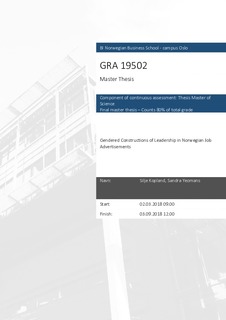Gendered Constructions of Leadership in Norwegian Job Advertisements
Master thesis
Permanent lenke
http://hdl.handle.net/11250/2580130Utgivelsesdato
2018Metadata
Vis full innførselSamlinger
- Master of Science [1621]
Sammendrag
Women are traditionally underrepresented in managerial positions, and
especially considering top managerial positions. Several factors might
contribute to keeping women from reaching their full potential and rise to top
positions in corporate contexts (Askehave & Zethsen, 2014). One factor that
might contribute to keeping women from rising to these types of positions
might be that the wording used in job advertisements do not appeal to them.
Thus, the theme of this thesis is the wording used in job advertisements, and
how this may have contributed to underrepresentation of women in managerial
positions. The theoretical framework used was based on a traditional
distinction between masculine and feminine stereotypical traits, such as women
being more communal, transformational and relationship-oriented, whereas
men are being more agentic, transactional and task-oriented. The present study
is a replication study of Askehave & Zethsen (2014) where we used a mixed
methods approach and conducted two different studies in order to investigate if
job advertisements for Norwegian top management positions were gender
biased. In study 1, we collected 50 Norwegian job advertisements and analyzed
these into semantic fields and categorized these according to theory on gender
stereotypes. Most of the semantic fields (7 out of 9) were identified as male
biased. Moreover, findings from this study also suggest that all job
advertisements were gender biased, and that an overwhelmingly majority of the
advertisements were male biased. For study 2, we conducted a questionnaire
with 20 authentic sentences from our corpus of job advertisements and asked
potential job applicants to rate each sentence as male or female biased.
Findings from this study suggest that the potential job applicants mostly agreed
with theory and our findings from study 1 (in 18 out of 20 sentences). In
conclusion, these findings imply that job advertisements for top managerial
positions in Norway are male-biased, even though most of the job
advertisements also mention several female characteristics in their
advertisements.
Beskrivelse
Masteroppgave(MSc) in Master of Science in Leadership and Organizational Psychology - Handelshøyskolen BI, 2018
